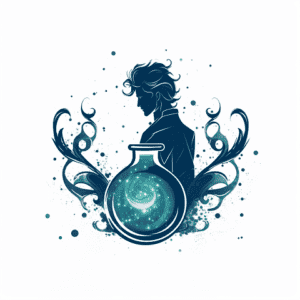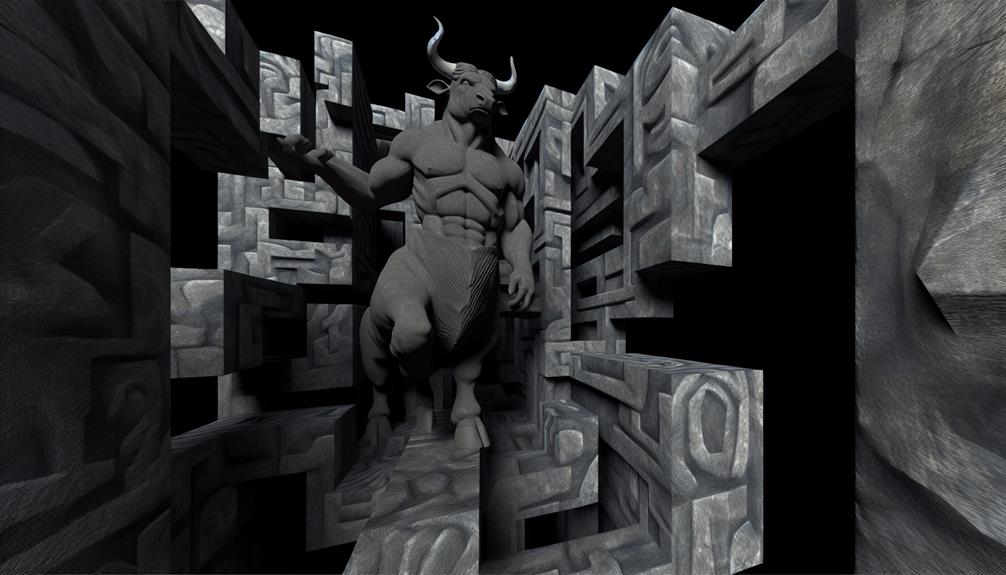As you navigate the labyrinth of ancient myths and legends, the tale of the Minotaur and the maze it inhabited beckons for exploration. The enigmatic creature, half-man and half-bull, trapped within the intricate confines of the labyrinth, has intrigued scholars and storytellers for centuries. But what deeper meanings lie beneath the surface of this captivating myth? And how has it continued to captivate and inspire interpretations throughout history?
The Legend of the Minotaur
Apologies for the brevity, but the legend of the Minotaur involves a half-man, half-bull creature confined within a labyrinth on the island of Crete. The origins of the Minotaur trace back to King Minos of Crete, who offended the god Poseidon and, as punishment, saw his wife Pasiphae fall in love with a bull. This union resulted in the birth of the Minotaur, a creature with a human body and a bull's head. The Minotaur's portrayal in the myth reflects its monstrous and fearsome nature, representing the primal and untamed aspects of existence.
The Minotaur's origins are shrouded in tragedy and divine retribution, as it was born from the consequences of King Minos' transgressions against the gods. This mythical creature's portrayal as a fearsome and formidable being underscores its role as a threat to the people of Crete. The construction of the labyrinth to contain the Minotaur highlights the terror it instilled in the hearts of the Cretans, while also emphasizing the need for a complex and cunning solution to subdue the creature. The Minotaur's portrayal as a monstrous entity to be feared and defeated adds depth to the legend and serves as a cautionary tale about the consequences of hubris and divine anger.
The Labyrinth of Crete
The Labyrinth of Crete, a complex and intricate structure, was designed to confine the fearsome Minotaur, embodying the terror it instilled in the hearts of the Cretans. The labyrinth's historical significance and the allure of labyrinth exploration continue to captivate the imagination. Here are three key aspects to consider:
- Architectural Marvel: The labyrinth, according to historical accounts, was an architectural marvel. Its construction was attributed to the legendary craftsman Daedalus, making it a testament to ancient engineering and design. The intricate layout and perplexing corridors added to its enigmatic nature, serving its purpose of confining the menacing Minotaur.
- Historical Significance: The labyrinth holds immense historical significance as it is not just a mythological construct, but an embodiment of the Minoan civilization's cultural and religious practices. Its existence and the tales surrounding it provide invaluable insights into the beliefs and societal structures of ancient Crete. As you delve into labyrinth exploration, you are not just navigating through passages, but also unraveling layers of history and myth.
- Enduring Mystery: Despite the passage of time, the labyrinth remains an enduring mystery. Scholars, historians, and enthusiasts continue to be intrigued by its enigmatic nature. The quest to unravel its secrets through labyrinth exploration fuels the imagination and offers a glimpse into the ancient world's complexities.
Symbolism and Interpretations
Steeped in allegory and mystery, the symbolism of the labyrinth and its diverse interpretations have intrigued scholars and enthusiasts for centuries. The labyrinth has been interpreted as a symbol of the human psyche, with its intricate passages representing the complexities of the mind. Its winding paths have been associated with the journey of life, full of twists and turns, and the search for inner truth and enlightenment. The hidden meanings within the labyrinth have also been linked to the unconscious mind, representing the layers of thoughts, emotions, and experiences that shape human behavior.
The Minotaur, as a fearsome creature lurking within the labyrinth, has been seen as a manifestation of the darker aspects of human nature, such as primal instincts and inner struggles. The slaying of the Minotaur by Theseus symbolizes the triumph of reason and heroism over chaos and savagery, reflecting the eternal struggle to overcome internal conflicts and find inner harmony.
Moreover, the labyrinth has been associated with spiritual and religious symbolism, representing the path to enlightenment, self-discovery, and transcendence. Its intricate design has been likened to mandalas, which are used in meditation and spiritual practice to achieve a sense of wholeness and unity.
Frequently Asked Questions
How Did the Myth of the Minotaur and the Labyrinth Influence Modern Literature and Popular Culture?
Influence on literature and modern adaptations of the myth of the Minotaur and the labyrinth is significant. Comparative mythology and cultural variations have shaped its enduring presence in popular culture, inspiring countless creative works across various mediums.
Are There Any Archaeological Findings or Evidence That Support the Existence of the Labyrinth on Crete?
Archaeological findings continue to unravel Cretan history, shedding light on lesser known interpretations and cultural variations. Ongoing research and excavation updates provide fascinating insights into the evolving portrayal of ancient myths and artistic depictions.
What Are Some Lesser-Known Interpretations of the Minotaur Myth in Different Cultures Around the World?
In various cultures, the myth of the Minotaur holds diverse cultural interpretations, each adding unique symbolism and significance to the story. These lesser-known perspectives enrich the understanding of this ancient tale.
How Has the Portrayal of the Minotaur Changed Over Time in Art and Literature?
Over time, the portrayal of the minotaur in art and literature has evolved significantly. Cultural influences, modern interpretations, and societal changes have shaped the representation of the minotaur, reflecting the dynamic nature of human storytelling.
Are There Any Ongoing Research or Excavations Related to the Minotaur and the Labyrinth?
Are there ongoing excavations and mythological interpretations of the Minotaur and the Labyrinth? Ongoing excavations continue to uncover new insights, while mythological interpretations provide a deeper understanding of this timeless tale.
Conclusion
Apologies for the brevity, but in the maze of life, we are all faced with our own Minotaur. The labyrinth may seem daunting, but it is within our power to conquer our fears and find our way out. Just as the hero Theseus defeated the Minotaur, we too can overcome our obstacles and emerge victorious. Let the legend of the Minotaur and the maze inspire you to face your own challenges with courage and determination.

